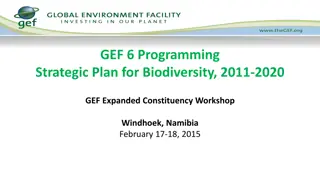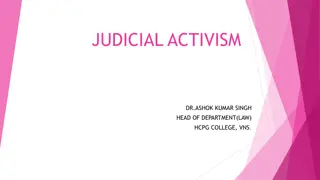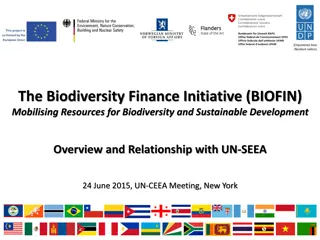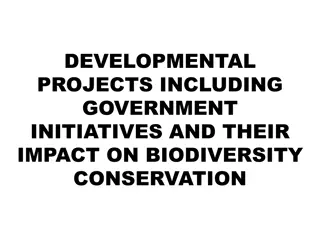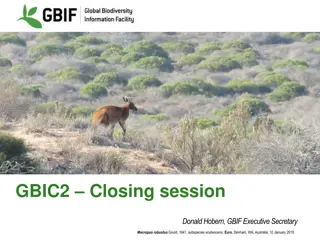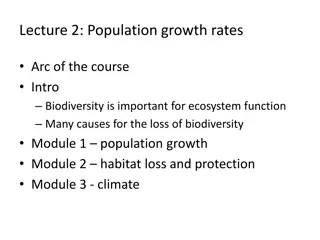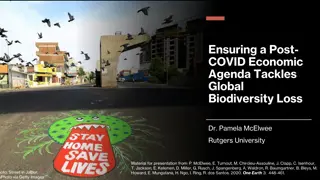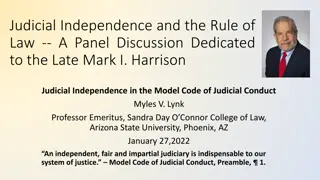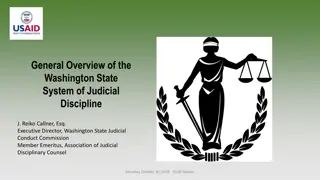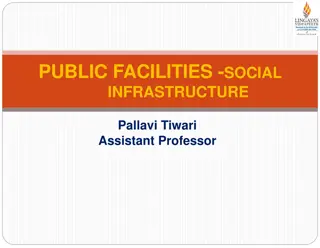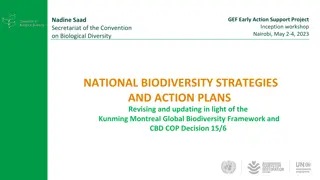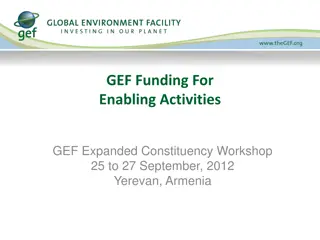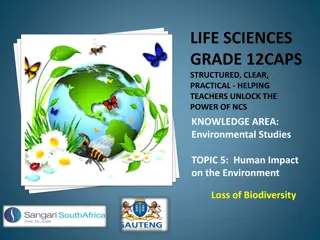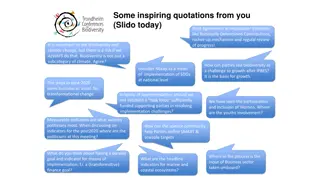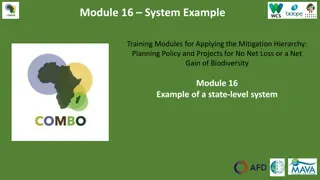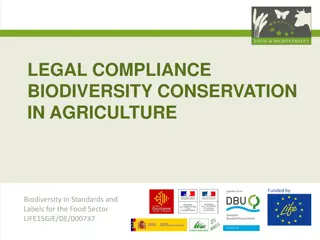Judicial Developments Impacting Biodiversity Conservation in the EU
Threatened species, declining habitats, and challenges in conservation efforts are highlighted in recent judicial developments in the EU. The need for stronger compliance, policy adjustments, and investment in environmental protection is evident from various reports and assessments. The focus on improving conservation outcomes and addressing gridlock in policies reflects ongoing efforts to safeguard biodiversity and ecosystems.
Download Presentation

Please find below an Image/Link to download the presentation.
The content on the website is provided AS IS for your information and personal use only. It may not be sold, licensed, or shared on other websites without obtaining consent from the author. Download presentation by click this link. If you encounter any issues during the download, it is possible that the publisher has removed the file from their server.
E N D
Presentation Transcript
Context Focus on 3 selected judicial developments Injunctions Agriculture/Nitrates Species protection / Hunting
Proceedings of the National Academy of Science, 2017 1,000,000 species currently threatened with extinction The average abundance of native species in most major land-based habitats has fallen by at least 20%, mostly since 1900. More than 40% of amphibian species, almost 33% of reef-forming corals and more than a third of all marine mammals are threatened UN Intergovernmental Science-Policy Platform on Biodiversity and Ecosystem Services (IPBES) Report, May 2019
+80% protected habitats; +60% protected species = unfavourable conservation status EU State of Nature Report, 2013 Only 50% of Natura 2000 sites have management plans with conservation objectives and measures 2017 Commission Action Plan for Nature, People and the Economy
April 2019 - 3rd assessment report to Commission: Habitats 85% Unfavourable Status 46% ongoing declines Species 57% Favourable 30% Unfavourable 72% Stable or improving trends
Vogels vision (2003): Policy gridlock and limited dismantling? Fitness Check (REFIT) Birds/Habitats Directives 2014 Largest ever response to a Commission consultation (500,000) Fit for purpose : December 2016
Focus shifts to compliance: EU Action Plan for Nature, People and the Economy (2017 2019) 4 Priority Areas Improving guidance + ensuring better coherence with broader socio economic objectives Building political ownership and strengthening compliance Investment and synergies with EU funding instruments Better communication and outreach Environmental Implementation Review (Biannual) 2018 Communication EU actions to improve environmental compliance (Rural areas, IMPEL peer review)
Share of Commission-initiated cases before the CJEU (Hofmann, 2019) Bottom line denotes environmental cases
Timmermans VP for Green New Deal An upgrading of environmental issues?
Case C-441/17 R Commission v Poland (Bialowieska Forest) Grand Chamber, November 2017 COM succeeds in request for interim measures Major active forest management operations allegedly in response to spread of spruce bark beetle no AA Genuineness of justification queried by CJEU in main judgment
1. Prima facie case: Action not prima facie without reasonable substance (POL accepted that did not check if adverse effect on integrity of the site) Differing scientific opinions Precautionary principle 2. Urgency: Operations are likely to cause irreparable and serious damage to the environment Transformation would be irreversible prima facie lack of scientific information excluding beyond all reasonable doubt that damaging and irreversible effects
3. Weighing up of interests POL had not explained why a temporary cessation of works would cause serious damage via spruce beetle Socio-economic interests do not appear to be of greater value than the interest of preserving the habitats and species at issue
Exclusion from the order: Where active management is strictly necessary and proportionate to ensure public safety of persons, where less damaging measures are impossible (signposting, etc) POL must take photographs before and after to discharge its burden
Unless order: POL to send COM details of all measures adopted to comply or COM can apply to reopen matter (at least 100K per day if proven) POL hadn t stopped works following VP provisional order July 2017 Sufficient material on file to prove ongoing works (Satellite images) Rejects claim that only Art 260 TFEU permits this Object and effectiveness of Art 279 TFEU
COM did not re-apply to the Court April 2018: Substantive judgment against POL Important Rule of Law implications Viz Portuguese, Polish judges cases
FIE v MCCAE (Simons J, 23 July 2019) Interim injunction granted suspending the entirety of an S.I. pending the outcome of the main proceedings Applying Okunade in EU law context Transfer of exclusive enforcement competence for industrial peat extraction to EPA, away from planning authorities; Enforcement holiday of transitional provisions
Simons J stayed 1 of 2 S.I.s comprising the new regulatory framework Temporary suspension of exemption from planning Acknowledges jurisdiction to suspend legislation should be most sparingly exercised Highly unusual facts of the case Very strong case of breach of EU law Especially serious breach in retrograde step At least in some instances a risk of harm to the environment would be created in interim period
Status quo ante Dual enforcement regime (EPA and planning) Bulrush v ABP (2018): confirms peat extraction is not exempted development Applies Okunade (2012) Has applicant established an arguable case? Where does the greatest risk of injustice lie? Would damages be an adequate remedy? Due weight to be given to the strength/weakness of the applicant s case
Simons J: Dowling v Minister for Finance (2013) adds a gloss to Okunade in challenges based on EU law Question is whether respondent has shown an arguable defence
Main judgment (Sept 2019) Regulations cannot temporarily remove the possibility of enforcement, even if the aim is ultimately to move to a more effective regime Must ensure that the requirements of the EIA and Habitats Directive are not circumvented Applying C-411/17 Inter Environnement Wallonie
C-293/17 etc Coperatie Mobilisation for the Environment NL authorisation schemes for agricultural activities causing nitrogen deposition on Natura 2000 sites Referring court: 118/162 NL Natura 2000 sites = excessive nitrogen deposition Nitrogen cover means risk to site Programmatic Nitrates Action plan in NL 2015 2021 Decide in advance what the critical overall deposition levels are per area Authorisation granted per project by NL provinces on the basis of that programme
CJEU 2018: Cattle grazing and application of fertilizers in vicinity of Natura 2000 sites = a project under Habitats Directive even if they are not a project under the EIA Directive (as not a physical intervention)
NL approach may be contrary to Art 6(3): Must be individual assessment of plans and projects Advance programmatic approach enables cumulative effects to be considered For national court to decide whether the scientific software used for the authorisation process here ensures that for each individual project Art 6(3) is complied with (no reasonable scientific doubt as to lack of adverse effect on integrity of the site) Can t take account of possible future intended nitrogen emissions unless these are certain
May 2019: NL Council of State rules that Provinces cannot grant authorisations on the basis of the Programme
Case C-647/17 Finnish Wolf Hunting Art 16 derogation to control population derogating from Art 12 ban on hunting only permitted if Based on rigorous scientific evidence No other means of achieving the aim Favourable conservation status must be ensured Must be an evaluation of the state of the populations and the impact thereon The Waddenzee of species protection?
Tenor of CJEUs Habitats judgments clear, consistent, and very demanding Facts are stark Means by which the issues are reaching the CJEU now largely preliminary reference, not infringement Fundamental rule of law challenges Almost 20% EU land area Vital challenge for MS (and society) to win hearts and minds of all stakeholders


